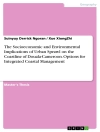The recent earthquake disasters in Japan and a series of other disasters in the world have highlighted again the need for more reliable geotechnical prediction and better methods for geotechnical design and in particular dealing with geohazards. This book provides a timely review and summaries of the recent advances in theories, analyses and methods for geotechnical predictions and the most up-to-date practices in geotechnical engineering and particularly in dealing with geohazards. A special section on the geotechnical aspects of the recent Tohoku earthquake disaster in Japan is also presented in this book.
Key Features: This book is written by a group of internationally renowned researchers and practioners to honour and mark the 40 years’ contribution of one of the greatest educators, researchers and engineers in the world, Professor Hideki Ohta, to geotechnical engineering. Professor Ohta is presently professor at Chou University after his retirement from Tokyo Institute of Technology, Japan. The book provides some first-hand information on the 2011 Tohuko earthquake disasters in Japan, the most recent update on the theories and methods for geotechnical analyses and predictions, and the latest methods and practices in geotechnical engineering, in particular, dealing with geotechnical hazard. It is a rare occasion for some 30 plus international authorities to write on their best topic that they have been working on for years. The book is a must-have collection for any libraries and professionals in geotechnical engineering.
Inhoudsopgave
Prologue – 40 years Contributions to Geotechnical Engineering of Prof Hideki Ohta.- Part 1: Geotechnical Aspects of Some Recent Disasters.- 1. Tsunami induced by 2011 Tohoku-Pacific Ocean earthquake and a possible renewal plan.- 2. Tsunami Damages: what is unexpected? – 3. Past Earthquakes in Indonesia and New Seismic Hazard Maps for Earthquake Design of Buildings and Infrastructures.- 4. Lessons learned from the recent natural disasters in Indonesia.- 5. Behaviour of slope protection and retaining structures during the 2008 Wenchuan Earthquake in China.- Part 2: Geotechnical Predictions.- 6. Consolidation and Creep Settlement of Embankment on Soft Clay: Prediction versus Observation.- 7. Numerical Simulation of Soil Structures Reinforced by Geosynthetics.- 8. Deformation Prediction of a Structure Placed on Soft Clay in Tokyo Bay Affected by Heavy Deep Well Pumping.- 9. Elasto-Plastic FEM Analysis and Safety Evaluation of Large Rockfill Dams during Reservoir Filling.- 10. Three Dimensional Soil/Water Coupled Analysis of Reverse Concreting Excavation Work.- 11. Spatial Discretization of Water Head in Soil-water Coupled Finite Element Analysis using HPM.- 12. Theoretical Analysis for Non-coaxiality of Toyoura Sand.- 13. Threshold of Friction Stabilizes Self-weight Transmission in Gravitating Loose Sand Heaps.- 14. Elasto-Plastic Constitutive Model for Unsaturated Soils with Subloading Surface Concept.- 15. Stress-Strain Relationship for the Singular Point on Yield Surface of Elasto-Plastic Constitutive Model and Quantification of Metastability.- 16. Analysis of the Earth Pressure Problems by Upper and Lower Equilibrium Method.- Part 3: Geotechnical Practices in Dealing with Geo-hazards.- 17. Railway Old Station Building: Enlargement and Underpinning.- 18. Analysis of slope stability and landslide in seismic activity regions.- 19. Recent Developments of PVD Soft Ground Improvement: Laboratory Test Results and Simulations.- 20. Study on Regional Ground Upheaval Phenomenon caused by the Rising of Groundwater Level and its Effect on Underground Infrastructure.- 21. A Robust Control Approach for Decision Making and Reliability Design of Soil Structures.- 22. Development of a Portable Triaxial Testing Apparatus -Smart Triaxial.- 23. Innovation in Disaster Mitigation Technologies.- Index.












